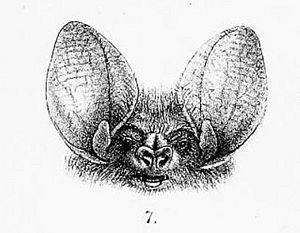South-eastern long-eared bat facts for kids
Quick facts for kids South-eastern long-eared bat |
|
|---|---|
 |
|
| Conservation status | |
| Scientific classification | |
| Genus: |
Nyctophilus
|
| Species: |
corbeni
|
The south-eastern long-eared bat, also called Nyctophilus corbeni or Corben's long-eared bat, is a type of bat found in Australia. It lives in the woodlands of the Murray Darling Basin and nearby areas.
Contents
About This Bat
Until 2009, scientists thought the south-eastern long-eared bat was a subspecies of the greater long-eared bat (Nyctophilus timorensis). However, new studies showed it is its own separate species. This change happened after a careful review of the Nyctophilus bat family. Before it became its own species, people often called it "Nyctophilus species 2". The first official discovery of this bat was in the Pilliga forest in New South Wales.
What Does It Look Like?
The south-eastern long-eared bat has a head and body that are about 50-75 mm long. Its tail is about 35-50 mm long. These bats have wide wings and a large tail membrane. This helps them fly slowly but with great control. Male bats are lighter, weighing 11-15 grams, while females are heavier, at 14-21 grams.
They have a wider skull and jaw, which helps tell them apart from other long-eared bats. This bat is a type of microbat. Most microbats have a wingspan of about 30 cm. Their wings stretch from their fingers down to their legs. The wing skin is amazing: it's soft, strong, and can even fix small holes by itself! Bats can control their flight by feeling the air. Their bodies are covered with tiny touch sensors. These are small bumps with tiny hairs that are sensitive to air movement.
Where Does It Live?
Nyctophilus corbeni lives in many types of inland woodlands. These include areas with box, ironbark, and cypress pine trees. They also live in Buloke, Belah, River Red Gum, and Black Box woodlands. You can also find them in different kinds of mallee vegetation.
These bats are much more likely to be found in large areas of forest. They prefer big tree hollows for their roosting spots. This shows how important it is to protect old trees. Female bats form small groups called maternity colonies inside tree hollows to raise their young. Male bats often hide under peeling bark in the summer. They usually fly a few kilometers from their roost to find food. They fly low to the ground, near tree trunks and other plants.
What Does It Eat?
The south-eastern long-eared bat hunts for food among the trees. It loves to eat insects! Beetles, bugs, and moths are common parts of its diet. This bat catches its prey while flying. This means it can stay in the air for hours at a time while it hunts.
How Does It Find Food?
Like all microbats, this bat uses echolocation to hunt and find its way around. They are very good at it! Echolocation calls are high-frequency sounds. Bats make these sounds by pushing air through their vocal cords, just like people speak.
These calls go out through their mouth or nose. When the sounds hit objects nearby, they bounce back as echoes. The bat's sensitive ears hear these echoes. Their brain then uses these faint echoes to figure out how far away objects are, how big they are, and even what they feel like.
A normal bat call can be 50,000 hertz (Hz) or 50 kilohertz (kHz). This sound wavelength is perfect for finding small insects. When a bat sends out a call, and it hits an insect, the echo tells the bat how far away the insect is.
The south-eastern long-eared bat uses a special type of echolocation. This helps them catch food using a technique called "gleaning." This means their echolocation creates a detailed picture. This allows them to find insects even if they are hidden against a tree trunk.
Where Can You Find It?
The south-eastern long-eared bat is rare in most places it lives. Its main home is around the Murray-Darling Basin in south-eastern Australia. You can find it in several protected areas. These include the Murray Sunset National Park in Victoria, the Yathong Nature Reserve in New South Wales, and the Danggali Conservation Park in South Australia. It also lives at the Commonwealth Reserve at Calperum Station in South Australia.
Reproduction and Life Cycle
We don't have much information about how the south-eastern long-eared bat reproduces. Like most bats, it is a placental mammal. This means the young develop inside the mother. Usually, they have one baby each year, though twins can happen.
Male bats become old enough to reproduce at about two years old. Females are ready after about one year. Females have two teats and feed their young milk for one to five months. Babies are born about 3 to 5 months after mating. This happens when there is plenty of food available. The young bats usually reach adult size by 3 months old. Pregnant females often gather together in maternity colonies a few weeks before giving birth.
What Threats Does It Face?
The south-eastern long-eared bat (Nyctophilus corbeni) is listed as "vulnerable." This means it is at risk of becoming endangered. Several things threaten these bats:
- Habitat loss: Their homes are being destroyed or broken into smaller pieces.
- Forestry activities: Logging and other forest work can harm their homes.
- Tree hollow competition: Other animals might compete for the tree hollows they need for roosting.
- Wrong fire management: Fires that are too frequent or too intense can damage their habitat.
- Predators: Wild animals like feral cats can hunt them.
- Chemicals: Exposure to farm chemicals can be harmful.
- Climate change: Changes in weather patterns can affect their food and homes.
Images for kids
See also
 In Spanish: Nyctophilus corbeni para niños
In Spanish: Nyctophilus corbeni para niños



